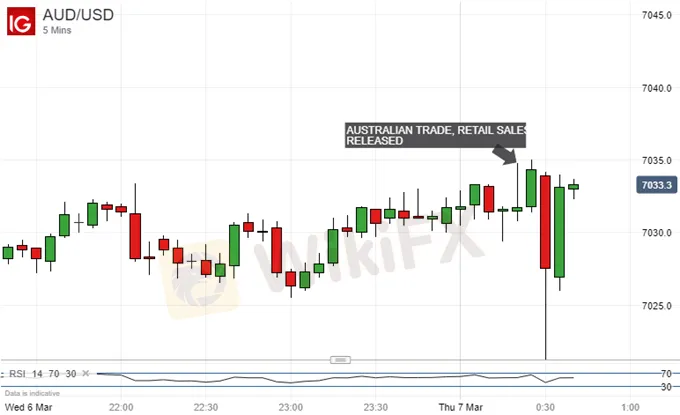Australian Dollar Steady On Retail Sales Weakness, Trade Strength
Abstract:The Australian Dollar was pulled in opposite directions by a feeble set of retail sales numbers released simultaneously with news of another strong trade surplus
Australian Dollar, Trade, Retail Sales Data, Talking Points:
Retail sales figures came in well below expectations for January
The trade balance registered a thirteenth straight surplu
None of this materially affects dovish monetary policy forecasts, which probably accounts for AUDs modest moves on the data
Find out what retail foreign exchange traders make of the Australian Dollars chances right now at the DailyFX Sentiment Page.
The Australian Dollar slipped a little Thursday following mixed data releases, with weaker retail sales clearly outweighing healthy trade numbers for investors.
January‘s sales rose 0.1% on the month, below the 0.3% markets had expected. This was better than December’s 0.4% fall but still a lackluster reading for an economy so dependent on consumers for growth.
This number will do nothing to alter expectations that Australian interest rates are probably headed lower so AUD/USDs modest slip should be no surprise.

January‘s trade balance was AUD4.55 billion, well above the 2.75 billion expected and a thirteenth straight month of surplus. Judging by these data the trade impasse between China and the US, and the general economic slowdown visible in many regions, has yet to significantly hit Australia’s exports, although weaker domestic demand may be flattering the figures.
February‘s construction Purchasing Managers Index came in at 43.8 earlier Thursday. That was better than January’s 43.1 but still deep in the sub-50 territory which signifies overall contraction in activity.
On its daily chart the Australian Dollar languishes at two-month lows against its US big brother. The Aussie has long had to contend with a complete lack of interest rate support, with markets moving to price in a cut in the record-low 1.50% Official Cash Rate late this year.
Now weakness has been exacerbated by cuts to the Reserve Bank of Australia‘s growth and inflation forecasts and a very weak official Gross Domestic Product reading for 2018’s final quarter.

The downtrend channel which marked much of last years trade is now back and, for as long as the Australian Dollar lack interest rate support, a lasting upside break will be difficult.
However, a trade settlement between the US and China would probably spur at least a knee-jerk surge in risk appetite which would all-but certainly see the Australian Dollar make gains. This must be regarded as the gravest near-term fundamental threat to a rather bearish AUD/USD prognosis.
Read more

Key Economic Calendar Events for This Week (August 5-9, 2024)
This week's economic events include: Japan's Monetary Policy Minutes and U.S. Services PMI on Monday, impacting JPY and USD. Tuesday's RBA Interest Rate Decision affects AUD, with German Factory Orders influencing EUR. Wednesday sees German Industrial Production and U.S. Crude Inventories impacting EUR and USD. Thursday: RBA Governor speaks, with U.S. Jobless Claims. Friday: China's CPI and Canada's Unemployment Rate affect CNY and CAD.

Key Economic Calendar Events for This Week
This week's key economic events include German retail sales, M3 money supply in South Africa, retail sales in Switzerland, and key rate decisions from the Federal Reserve and the Bank of England. The U.S. will also release its Nonfarm Payrolls, unemployment rate, and ISM Manufacturing PMI. These events are crucial for gauging economic health and guiding currency valuations.

Economic and Political Shifts Impact Global Markets Part 2
Recent developments include President Biden's potential re-election reconsideration, Asia-Pacific market highs, PwC's auditing issues in China, potential acquisitions in the energy and retail sectors, geopolitical tensions, and regulatory actions impacting markets. Key impacts include fluctuations in USD, CNY, CAD, TWD, EUR, GBP, and AUD, with significant effects on stock markets across the US, Asia, and Europe.

Economic and Political Shifts Impact Global Markets Part 1
Recent developments include President Biden's potential re-election reconsideration, Asia-Pacific market highs, PwC's auditing issues in China, potential acquisitions in the energy and retail sectors, geopolitical tensions, and regulatory actions impacting markets. Key impacts include fluctuations in USD, CNY, CAD, TWD, EUR, GBP, and AUD, with significant effects on stock markets across the US, Asia, and Europe.
WikiFX Broker
Latest News
TriumphFX: The Persistent Forex Scam Draining Millions from Malaysians
Lawmakers Push New Crypto ATM Rules to Fight Fraud
2025 WikiFX Forex Rights Protection Day Preview
PH Senator Probes Love Scams Tied to POGOs
Mastering Calm: How to Stay Cool in Forex Trading?
The End of Costly USDT Transfers: Tron Reshapes Stablecoin Transactions
BP\s shareholders want it to make money, not climate policy
2025 SkyLine Guide Thailand Opening Ceremony: Jointly Witnessing New Skyline in a New Chapter
Why does Botbro change the domain name?
Safety Alert: FCA Discloses These 11 Unlicensed Financial Websites
Rate Calc

